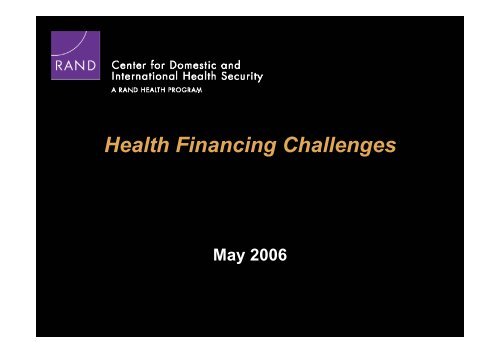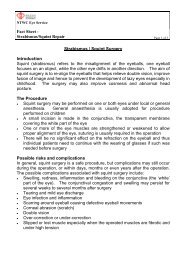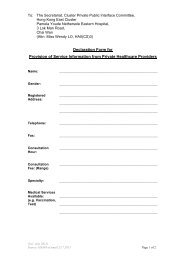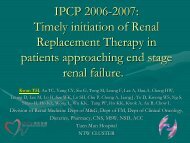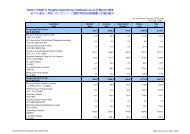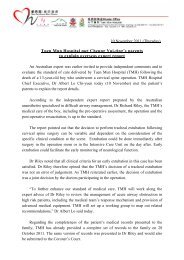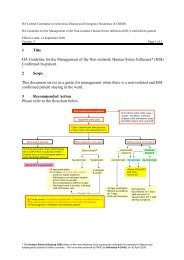Health Financing Challenges
Health Financing Challenges
Health Financing Challenges
- No tags were found...
You also want an ePaper? Increase the reach of your titles
YUMPU automatically turns print PDFs into web optimized ePapers that Google loves.
<strong>Health</strong> <strong>Financing</strong> <strong>Challenges</strong>May 2006
Overview1. Principles of health financing2. Most common models3. Some observations from RAND research4. China’s health financing system
In Most Countries, <strong>Health</strong> Care Policy InvolvesBalancing Key Goals for the <strong>Health</strong> SystemKey <strong>Health</strong> System GoalsHighQualityCostControlsUniversalAccessChoice ofProviders
<strong>Financing</strong> Is Part of the Foundation for a Successful<strong>Health</strong> System<strong>Health</strong>y PeopleQuality CareTechnologyPrimary CarePublic <strong>Health</strong>Research<strong>Financing</strong>Planning, Management & Evaluation<strong>Health</strong> System Goals
Principles of <strong>Health</strong> <strong>Financing</strong>RevenueCollectionPoolingPurchasing
Collecting Revenues Is Crucial for<strong>Financing</strong> the <strong>Health</strong> SystemRaising sufficient &sustainable revenuesCollecting revenuesfor the healthsystem means…Raising revenuesin an equitable &efficient mannerRaise sufficient resourcesto cover public health,primary & basic careProtecting peoplefrom financial hardshipif sick or injured
Pooling Is the Core Principle of Insurance:(spread risk so no individual has catastrophic expenses)Creating pools thatefficiently managehealth risksPooling revenuesfor the healthsystem means…Creating pools that alsoequitably managehealth risks
Efficient Purchasing of Services Is Key to<strong>Health</strong> System PerformancePurchasing inthe healthsystem means…Using resources topurchase the “right amount”of servicesUsing resources topurchase the “right kind”of services
Overview1. Principles of health financing2. Most common models3. Some observations from RAND research4. China’s health financing system
Models of <strong>Health</strong> <strong>Financing</strong> SystemsNational <strong>Health</strong>ServiceSocial <strong>Health</strong>InsurancePrivate <strong>Health</strong>InsuranceMain revenue type:General taxesPooling:National poolPurchasing:National or regionaldirect purchase ofservicesMain revenue type:Payroll taxPooling:Pools by job orincomePurchasing:Collective andselective contractsMain revenue type:Individual &employer paymentsPooling:Privately managedpoolsPurchasing:Selective contracts
<strong>Health</strong> <strong>Financing</strong> Systems Around the WorldNational <strong>Health</strong>ServiceSocial <strong>Health</strong>InsurancePrivate <strong>Health</strong>Insurance• United Kingdom• Canada• New Zealand• Australia• Italy• France• Germany• Japan• United States• Greece• SingaporeMost countries have mixed financing systems withboth public and private sources of funds
Some “Pros” of Each <strong>Health</strong> <strong>Financing</strong> SystemNational <strong>Health</strong>ServiceSocial <strong>Health</strong>InsurancePrivate <strong>Health</strong>Insurance• Universal healthcoverage•Pools risks forwhole population• Relies on a solidsource of revenue• Potential foradministrativeefficiency and costcontrol• Most countrieshave achieveduniversal coverage•Relies on diverseand numeroussources of funds•Defined benefitspackage• Sophisticatedpayment systems• Offers greatercoverage andchoice for thosewilling to buy it• Potential forincreasedcompetition
Some “Cons” of Each <strong>Health</strong> <strong>Financing</strong> SystemNational <strong>Health</strong>ServiceSocial <strong>Health</strong>InsurancePrivate <strong>Health</strong>Insurance• Lack of definedbenefits packageleads to geographicvariation in coveredservices• Potential for carerationing andwaiting lists• Multiple fundscomplicate efficientmanagement ofresources• Defined benefitstend to focus oncurative rather thanpreventive care• Decisions aboutadding benefitsdifficult and costly• Can be expensiveand regressive• Coverage levelsacross productsvary widely• Requires strongregulatory oversight• Not an effectivemechanism forachieving universalcoverage (e.g. U.S.)
Overview1. Principles of health financing2. Most common models3. Some observations from RAND research4. China’s health financing system
RAND’s Research on <strong>Health</strong> Care FinanceRAND has developed a wide range of innovative approachesfor addressing key issues in health financing and economicsResearch areas include:– <strong>Health</strong> insurance (e.g., effect on access to care)– Managed care (e.g., effect on health care markets andvulnerable populations)– Prescription drug benefits (e.g., effects of benefits onhealth of chronic care patients)– <strong>Health</strong> system design and evaluation (e.g., Qatar,Palestine
RAND’s <strong>Health</strong> Insurance Experiment• Objective: tested how cost sharing affected use ofmedical services and health• Results:– Cost sharing reduces spending– Cost sharing reduces use of all kinds of treatment– People reduce both essential and non-essentialcare– Cost sharing does not affect quality of care– Cost sharing does not affect health, except for thevery poor and the very sick
Overview1. Principles of health financing2. Most common models3. Some observations from RAND research4. China’s health financing system
China’s <strong>Health</strong> <strong>Financing</strong> System Mixes All Three“Traditional” and Some “New” ModelsTraditional Models• A “national” health service funded by central, provincialand county government budgets• Social insurance for employees of government andstate-owned enterprises• Small but growing private insurance marketNew Models• Community-based financing schemes in someprovinces• Medical savings accounts in some urban areas
China’s <strong>Health</strong> Care System:Rapid Success in the 1960s & 1970s• Doubled life expectancy, compared with 1930s and40s• Comprehensive systems of health care set up inrural and urban areas• Praised by the World <strong>Health</strong> Organization as amodel of primary health care• Rapid change in improving quality of careHowever, the Chinese health care system has undergonesignificant changes over the past 20 years
In General, <strong>Health</strong> Insurance Coverage inChina Has Fallen Since 19938070% ofpopulationcovered6050403020100RuralUrban199319982003Source: World Bank
Many in China Have No Accessto <strong>Health</strong> InsuranceInsurance SystemsUrbanRuralPublic insuranceCooperative medicalinsurancePrivate insurance43%7%6%3%10%8%No insurance45%79%Source: 2003 National <strong>Health</strong> Services Survey, Chinese Ministry of <strong>Health</strong>
China’s Child Mortality RateHas Not Fallen as Predicted1960s 1970s 1980s 1990s0-1-2-3-4-5-6-7Actual % ChangePredicted % ChangeSource: World Bank
China’s Reform Efforts Face Key <strong>Challenges</strong>• Large, aging population; increasing chronic disease• Individuals covered by rural plans who migrate to urbanareas have no coverage under urban plans• Most reforms do not appear to protect the poor, whopay a higher share of income toward health care• Most health spending is on hospital rather than primarycare• Rapid development is adding to environmental healthproblems• Demand among affluent for technology-intensive healthcare is increasing
<strong>Financing</strong> Will Be Key to SuccessTo improve its health system, China needs to:• Develop data and surveillance systems that cansupport the magnitude of the change• Invest in health service research to measure,evaluate, and guide system reformSmall changes in financing will have hugeeffects on costs, access, and quality


